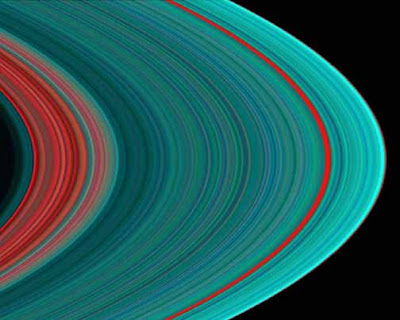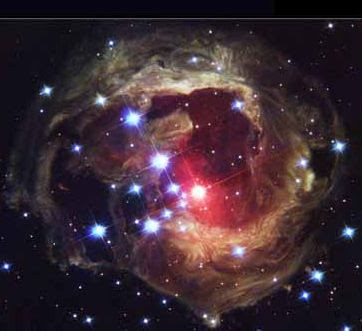
Sunday, November 23, 2008
Saturday, November 1, 2008
NEBULAS

The Trifid Nebula. A 'stellar nursery', 9,000 light years from here, it is where new stars are being born.

The glowering eyes from 114 million light years away are the swirling cores of two merging galaxies called NGC 2207 and IC 2163 in the distant Canis Major constellation.

Starry Night, so named because it reminded astronomers of the Van Gogh painting. It is a halo of light around a star in the Milky Way.

The Perfect Storm, a small region in the Swan Nebula, 5,500 light years away, described as 'a bubbly ocean of hydrogen and small amounts of oxygen, sulphur and other elements'.

The Cone Nebula. The part pictured here is 2.5 light years in length (the equivalent of 23 million return trips to the Moon).

The Hourglass Nebula, 8,000 light years away, has a 'pinched-in-the-middle' look because the winds that shape it are weaker at the centre.
EAS ENTERS OUR ATMOSPHERE ON NOV 3
Space Weather News for Nov. 1, 2008
http://spaceweather.com
More than a year ago, in July 2007, International Space Station astronauts threw an obsolete, refrigerator-sized ammonia reservoir overboard.
Ever since, the 1400-lb piece of space junk has been circling Earth in a decaying orbit--and now it is about to reenter.
If predictions are correct, the "Early Ammonia Servicer" (EAS for short) will turn into a brilliant fireball as it disintegrates in Earth's atmosphere during the early hours of Monday, Nov. 3rd.
Uncertainties in the exact reentry time are so great (plus or minus 15 hours at the time of this alert) that it is impossible to pinpoint where the fireball will appear.
At the moment, every continent except Antarctica has some favorable ground tracks.
Readers should check our Satellite Tracker (http://spaceweather.com/flybys/) for possible overflights.
Before reentry, the EAS will seem about as bright as a 2nd or 3rd magnitude star, similar to the stars of the Big Dipper.
During re-entry, the disintegrating reservoir could light up like a full Moon.
Flyby predictions should be regarded as approximate because the orbital elements of the EAS are now changing so rapidly.
Updates will be posted on http://spaceweather.com.
http://spaceweather.com
More than a year ago, in July 2007, International Space Station astronauts threw an obsolete, refrigerator-sized ammonia reservoir overboard.
Ever since, the 1400-lb piece of space junk has been circling Earth in a decaying orbit--and now it is about to reenter.
If predictions are correct, the "Early Ammonia Servicer" (EAS for short) will turn into a brilliant fireball as it disintegrates in Earth's atmosphere during the early hours of Monday, Nov. 3rd.
Uncertainties in the exact reentry time are so great (plus or minus 15 hours at the time of this alert) that it is impossible to pinpoint where the fireball will appear.
At the moment, every continent except Antarctica has some favorable ground tracks.
Readers should check our Satellite Tracker (http://spaceweather.com/flybys/) for possible overflights.
Before reentry, the EAS will seem about as bright as a 2nd or 3rd magnitude star, similar to the stars of the Big Dipper.
During re-entry, the disintegrating reservoir could light up like a full Moon.
Flyby predictions should be regarded as approximate because the orbital elements of the EAS are now changing so rapidly.
Updates will be posted on http://spaceweather.com.
Thursday, October 30, 2008
COMETAS

Comet Hyakutake (C/1996 B2), 23 March 1996, 09:30 UT.
30 minute guided exposure on Ektachrome 100.
This image was taken with a camera piggybacked on my SCT.
The head of the comet is seen at R.A. 14:46:48, dec 27° 38' 21", just passing 2.4 mag Izar (36 epsilon Boötes).
The bright star near the bottom of the image is Arcturus.
The tail is about 15° long.

Comet Hyakutake (C/1996 B2), 27 March 1996, 00:00 UT.
15 minute exposure on Ektachrome 100.
The comet is passing about 4° from Polaris.
The two bright stars in the 11 o'clock direction are 23 delta Ursa Minor and 22 epsilon Ursa Minor, the middle two stars in the handle of the Little Dipper (Polaris is the end star in the handle).
The tail is about 12° long.
© Copyright 2002, Chris L Peterson. All rights reserved.
Thursday, October 2, 2008
Tuesday, September 30, 2008
GALERIA DE AURORAS
AURORA WATCH: A solar wind stream is buffeting Earth's magnetic field and causing geomagnetic storms around the Arctic Circle. "Stunning!
Yuichi Takasaka, Yellowknife, Northwest Territories, CanadaSep. 3, 2008
Lance Parrish, Skiland, AlaskaSep. 2-4, 2008

Yuichi Takasaka, Lady Evelyn Falls, near Kakisa, Northwest Territories, CanadaSep. 2, 2008
JULES VERNE ENTERED THE EARTH ATMOSPHERE

Goodbye, Jules Verne. The robotic cargo carrier was deliberately guided into the atmosphere by European mission controllers, bringing an end to a successful 6-month mission.
In April 2008, Jules Verne performed the first-ever automated docking to the International Space Station (ISS), delivering more than 2 tons of supplies without any assistance from human controllers. The spacecraft quickly became a valuable part of the ISS. Several times Jules Verne used its engines to reboost the space station's orbit, once helping to dodge a piece of space junk, while the spacious interior of the cargo ship became an impromptu bedroom and "hygiene center" for the crew. Eventually, Jules Verne was re-filled with trash and on Sept. 29th it was sent back to Earth.
Scientists onboard a NASA DC-8 research plane photographed the reentry. They're studying how spacecraft and meteoroids break apart in Earth's atmosphere--and Jules Verne provided valuable data. Stay tuned for their findings.
In April 2008, Jules Verne performed the first-ever automated docking to the International Space Station (ISS), delivering more than 2 tons of supplies without any assistance from human controllers. The spacecraft quickly became a valuable part of the ISS. Several times Jules Verne used its engines to reboost the space station's orbit, once helping to dodge a piece of space junk, while the spacious interior of the cargo ship became an impromptu bedroom and "hygiene center" for the crew. Eventually, Jules Verne was re-filled with trash and on Sept. 29th it was sent back to Earth.
Scientists onboard a NASA DC-8 research plane photographed the reentry. They're studying how spacecraft and meteoroids break apart in Earth's atmosphere--and Jules Verne provided valuable data. Stay tuned for their findings.
Thursday, September 18, 2008
DOOMED SPACECRAFT

Jules Verne is about to become a fireball.
On Sept. 29th, with NASA aircraft looking on, the 22-ton European spacecraft will plunge into Earth's atmosphere over the south Pacific Ocean and harmlessly disintegrate.
Jules Verne recently spent five months docked to the space station where it delivered supplies, used its engines help the station avoid a piece of space junk, and served as an impromptu bedroom for the ISS crew.
Mission accomplished, the doomed spacecraft is now making its final orbits around Earth glowing about as brightly as Polaris (the North Star).
US and European observers are favored with flybys this weekend.
If you'd like to see Jules Verne, check the Simple Satellite Tracker for viewing times: http://spaceweather.com/flybys/
On Sept. 29th, with NASA aircraft looking on, the 22-ton European spacecraft will plunge into Earth's atmosphere over the south Pacific Ocean and harmlessly disintegrate.
Jules Verne recently spent five months docked to the space station where it delivered supplies, used its engines help the station avoid a piece of space junk, and served as an impromptu bedroom for the ISS crew.
Mission accomplished, the doomed spacecraft is now making its final orbits around Earth glowing about as brightly as Polaris (the North Star).
US and European observers are favored with flybys this weekend.
If you'd like to see Jules Verne, check the Simple Satellite Tracker for viewing times: http://spaceweather.com/flybys/
Wednesday, September 17, 2008
ALINEACION DE CUATRO PLANETAS

Miles de personas la alineación de cuatro planetas
Miles de personas se han dado cita en el Planetario de Madrid para observar la alineación de cuatro planetas Mercurio, Venus, Saturno y Marte-, la Luna y una estrella muy brillante llamada Régula
Los aficionados, se han acercado con sus prismáticos a las pasarelas del Planetario para lograr visualizar la alineación de los cuatro planetas en la constelación de Leo
El primer planeta en distinguirse como un punto brillante ha sido Mercurio, mucho más alto se ha divisado Venus, justo encima Saturno y más elevado aún Marte, aunque su visión resultó afectada por las condiciones meteorológicas y contaminación del día
Este fenómeno se produce cuando, por un efecto de perspectiva al mirar desde la Tierra, se puede observar en el cielo dos o más planetas muy próximos entre sí, aunque en realidad estén separados por millones de kilómetros en el espacio
A la hora del crepúsculo, se ha podido contemplar Júpiter y ya entrada la noche, la Luna, justo en fase de cuarto creciente en la constelación de Libra, cuya imagen ha sido proyectada en directo por una gran pantalla
Miles de personas se han dado cita en el Planetario de Madrid para observar la alineación de cuatro planetas Mercurio, Venus, Saturno y Marte-, la Luna y una estrella muy brillante llamada Régula
Los aficionados, se han acercado con sus prismáticos a las pasarelas del Planetario para lograr visualizar la alineación de los cuatro planetas en la constelación de Leo
El primer planeta en distinguirse como un punto brillante ha sido Mercurio, mucho más alto se ha divisado Venus, justo encima Saturno y más elevado aún Marte, aunque su visión resultó afectada por las condiciones meteorológicas y contaminación del día
Este fenómeno se produce cuando, por un efecto de perspectiva al mirar desde la Tierra, se puede observar en el cielo dos o más planetas muy próximos entre sí, aunque en realidad estén separados por millones de kilómetros en el espacio
A la hora del crepúsculo, se ha podido contemplar Júpiter y ya entrada la noche, la Luna, justo en fase de cuarto creciente en la constelación de Libra, cuya imagen ha sido proyectada en directo por una gran pantalla
Sunday, September 7, 2008
Saturday, August 23, 2008
Subscribe to:
Posts (Atom)








































